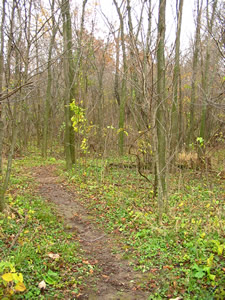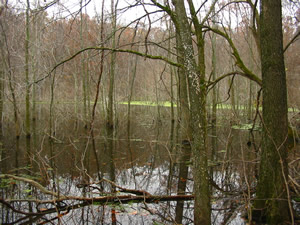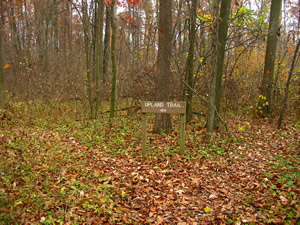


Stop 6: The Winter and Summer Trail Junction
 The trail splits just past Woodie Retreat. The winter trail
heads back into the second-growth deciduous forest while the summer trail
follows the forest edge near the large open wetland.
The trail splits just past Woodie Retreat. The winter trail
heads back into the second-growth deciduous forest while the summer trail
follows the forest edge near the large open wetland.
The winter trail provides its visitors with a rare glimpse of a forest in the Limberlost area. Most forests were destroyed at the turn of the twentieth century while Gene Stratton-Porter was living just northeast of the Loblolly Marsh in Geneva.
"In its day it covered a large area. . . . Now, the Limberlost exists only in ragged spots and patches. . . . . Canadian lumbermen came seeking tall straight timber for ship masts and tough heavy trees for beams. . . . . Then a ditch was dredged across the North and through my best territory, and that carried the water to the Wabash River until oilmen could enter the swamp."
-Gene Stratton-Porter
Moths of the Limberlost, 1912
 The
trail gives wildlife enthusiasts and photographers a different view
of Woodie Retreat.
The
trail gives wildlife enthusiasts and photographers a different view
of Woodie Retreat.
 The
Winter Trail also splits. The upland trail wanders around through the
forest, taking hikers up small bluffs and back down again, eventually
ending at the summer trail. The bottomland trail heads directly toward
the
summer trail and is much shorter.
The
Winter Trail also splits. The upland trail wanders around through the
forest, taking hikers up small bluffs and back down again, eventually
ending at the summer trail. The bottomland trail heads directly toward
the
summer trail and is much shorter.
Source:
Stratton-Porter, Gene. Moths of the Limberlost. New York: Doubleday Page & Co., 1912.
The Loblolly Virtual Nature Trail was created as a part of the Our Land, Our Literature website.